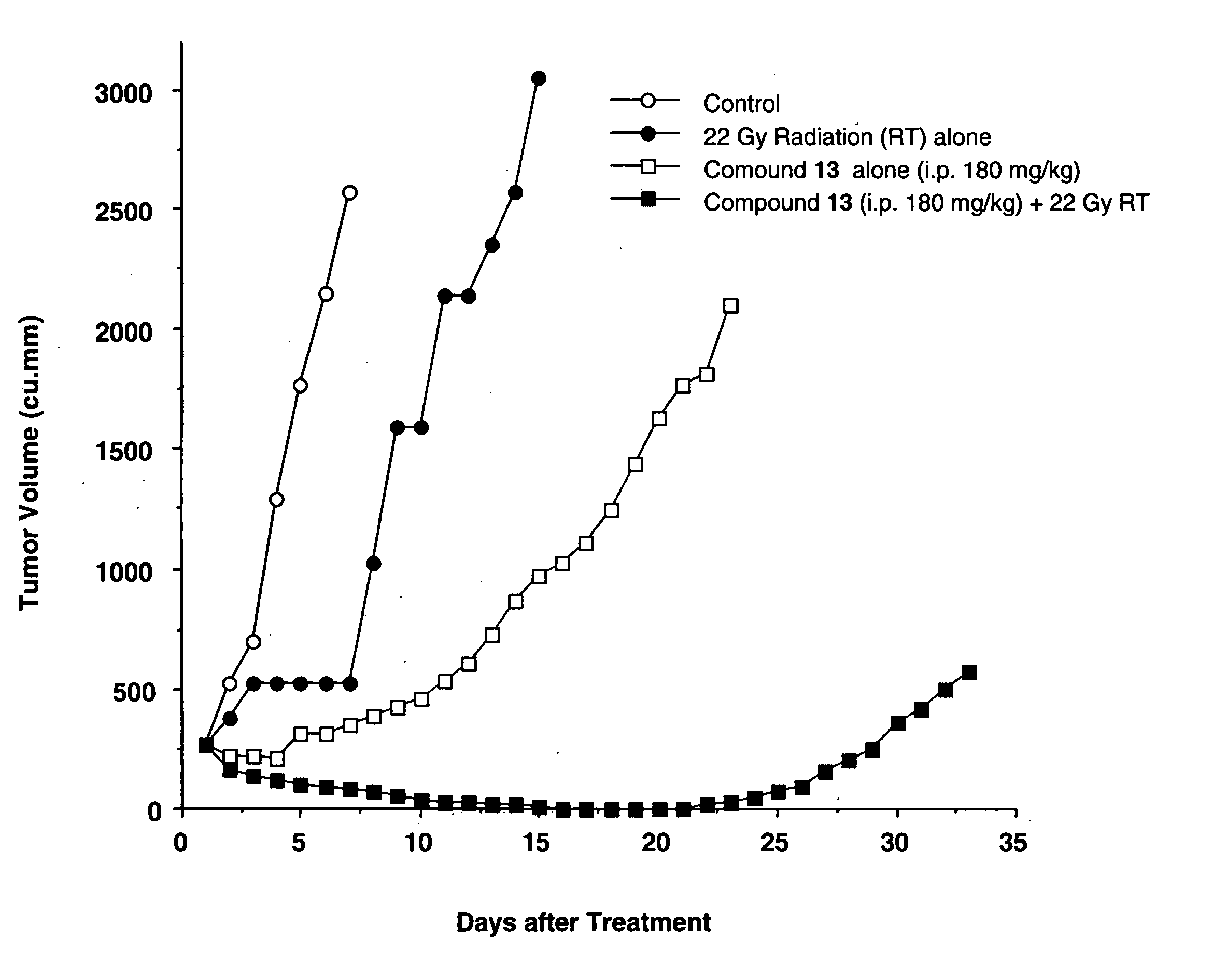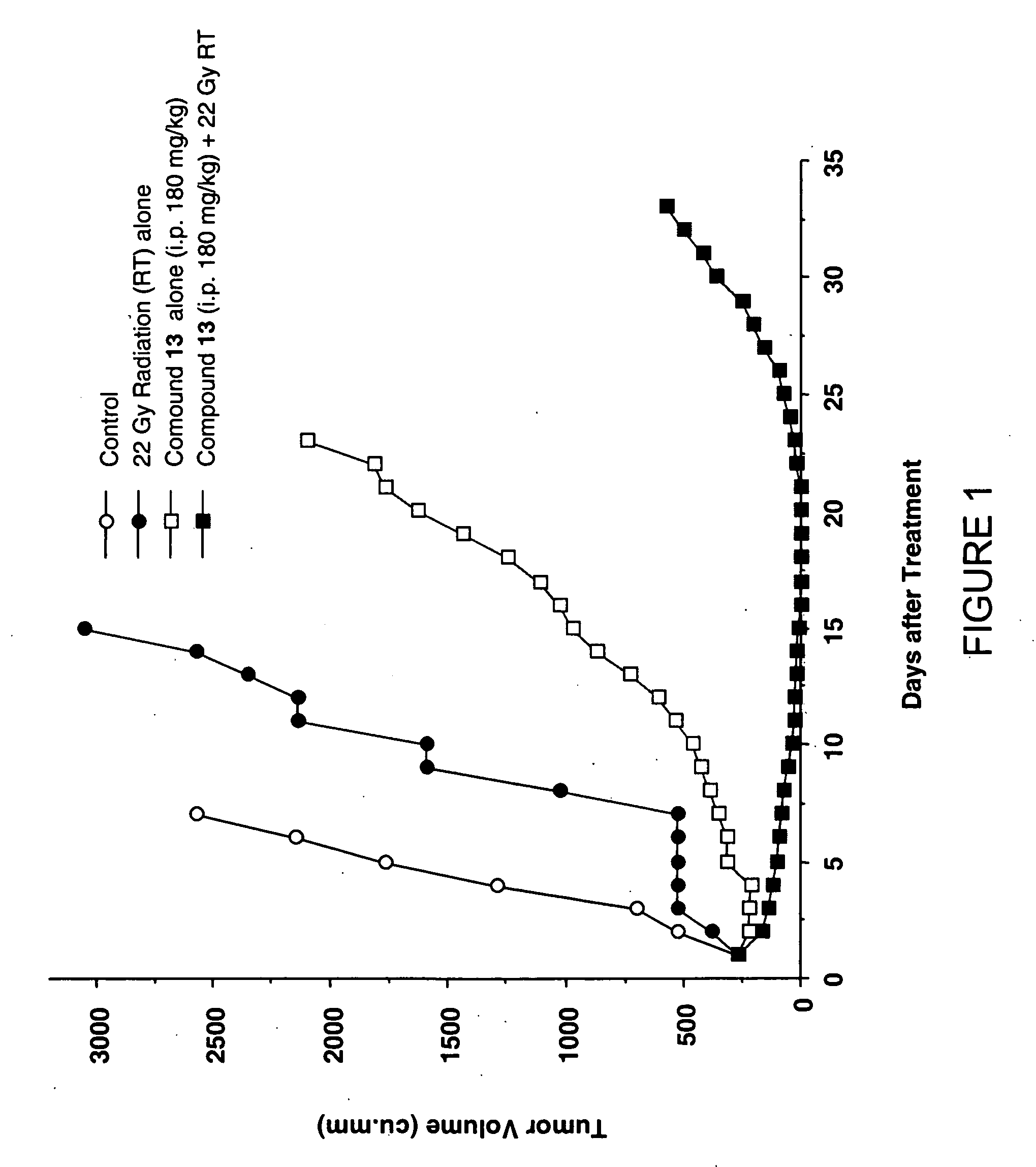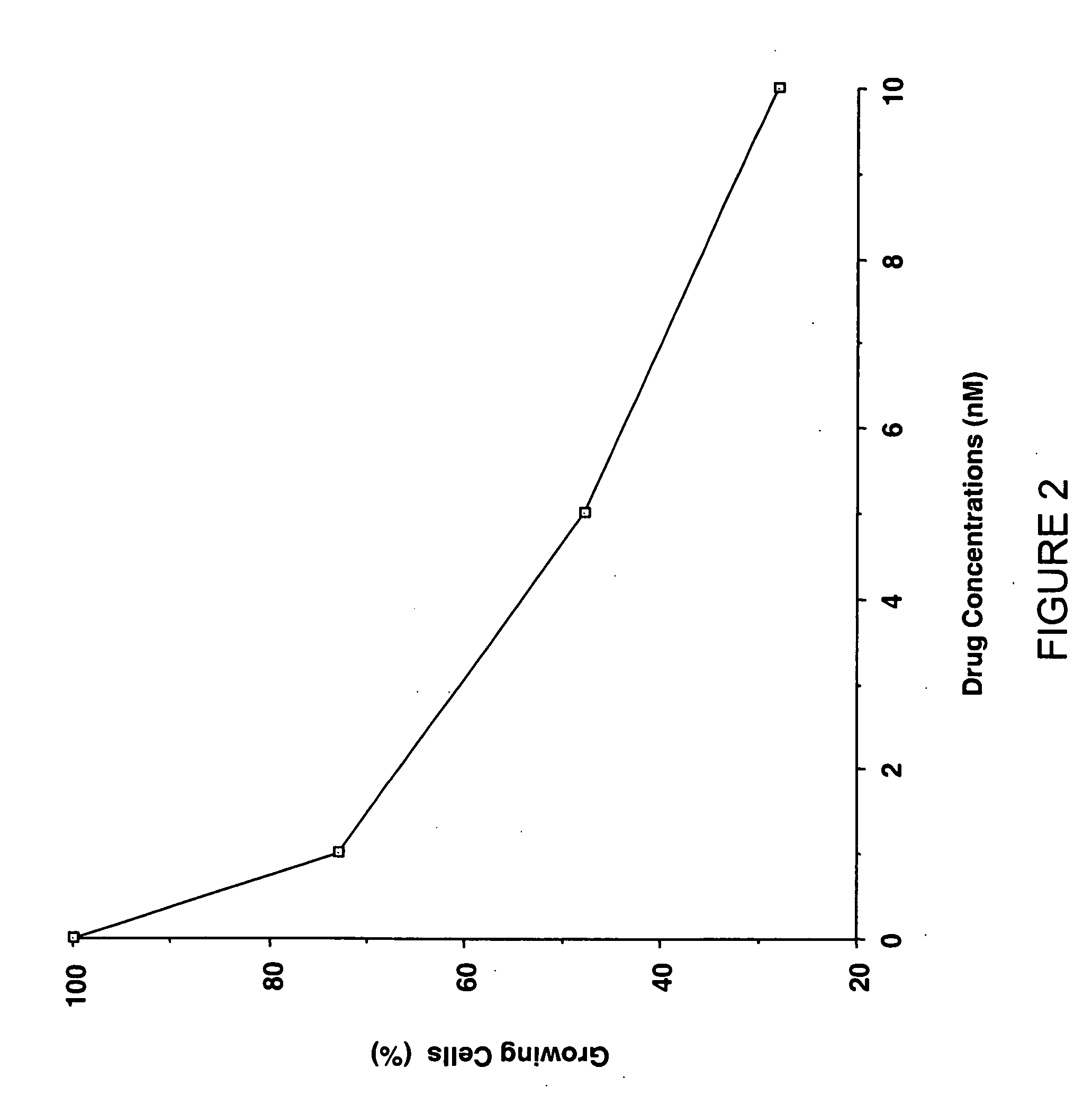Camptothecin derivatives as chemoradiosensitizing agents
a technology of chemoradiosensitizing agent and derivative, applied in the direction of biocide, group 5/15 element organic compound, drug composition, etc., can solve the problems of local recurrence remaining a major obstacle, poor likelihood of long-term survival, and translation
- Summary
- Abstract
- Description
- Claims
- Application Information
AI Technical Summary
Benefits of technology
Problems solved by technology
Method used
Image
Examples
example 1
10-tert-butoxycarbonyloxycamptothecin (7, Boc-10H-CPT)
[0499]
[0500] (BOC)2O (12 g, 54.79 mmol) and 10-hydroxy-camptothecin (10 g, 27.40 mmol) were dissolved in DMF (137 mL) and pyridine (46 mL) was added. The mixture was stirred at rt overnight. The reaction mixture was diluted with DCM (800 mL) and washed with water (3×300 mL), 1 N HCl (3×300 mL) and dried over Na2SO4. The solvent was evaporated to give 12 g of crude product 7 (94%). 1H NMR (CDCl3): δ 8.34 (s, 1H, Ar), 8.25 (s, 1H, Ar), 8.21 (s, 1H, Ar), 7.75 (d, 1H, J=2.4 Hz, Ar), 7.67 (s, 1H), 7.66 (dd, J=8.0, 2.4 Hz, 1H, Ar), 5.75 (d, J=16.5 Hz, 1H, —C—CH2—O—C(O)—), 5.31 (d, J=16.5 Hz, 1H, —C—CH2—O—C(O)—), 5.30 (s, 2H, —C—CH2—N—), 1.91 (m, J=6 Hz, 2H, CH2-Me), 1.62 (s, 9H, t-Bu), 1.06 (t, J=6 Hz, 3H, CH3).
20-O-(TNF-ethanoyl)-Boc-10H-CPT ester (8)
[0501]
[0502] To a solution of TNF-ethanoic acid 4 (4.3 g 9.95 mmol), Boc-10H-CPT 7 (3.08 g, 6.63 mmol) and DIC (3.08 mL, 19.89 mmol) in anhydrous DCM (120 mL) was added a solution of D...
example 2
20-O-[(+)TAPA]-Boc-10H-CPT ester (9)
[0628]
[0629] To a solution of (+)TAPA 3a (360 mg, 0.81 mmol), Boc-10H-CPT 7 (250 mg, 0.54 mmol), Hobt (80 mg, 0.59 mmol) and DIC (250 μL, 1.61 mmol) in anhy DCM (10 mL) was added a solution of DMAP (26 mg, 0.22 mmol) in anhy DCM (1 mL). After 1 hr at rt, DIC (250 μL, 1.61 mmol) and (+)TAPA 3a (120 mg, 0.27 mmol) were added. The reaction was stirred at rt overnight. The mixture was diluted with DCM (50 mL) and washed with 1N HCl (2×25 mL), saturated aq NaHCO3 solution (2×25 mL), dried over Na2SO4, treated with activated carbon and filtered. The solvent was evaporated and the remaining residue was purified by silica gel column with 50-80% EtOAc:Hexanes to give 400 mg of 20-O-[(+)TAPA]-Boc-10H-CPT ester 9 as yellow solid (85%). 1H NMR (CDCl3) δ 9.40 (s, 1H, Ar), 8.85 (s, 1H, Ar), 8.54 (s, 1H, Ar), 8.33 (s, 2H, Ar), 7.83-7.58 (m, 3H), 7.17 (s, 1H), 5.68 (d, 1H, J=17.4 Hz, —C—CH2—O—C(O)—), 5.52-5.42 (m, 2H, —C—CH2—O—C(O)— and O—C(O)—CH(Me)-O—), 5.28 (...
example 3
20-O-[(−)TAPA]-Boc-10H-CPT ester (11)
[0757]
[0758] To a solution of (−)TAPA 3b (1.44 g, 3.23 mmol), Boc-10H-CPT 7 (1 g, 2.15 mmol), Hobt (320 mg, 2.37 mmol) and DCC (1.33 g, 6.45 mmol) in anhy DCM (40 mL) was added a solution of DMAP (105 mg, 0.86 mmol) in anhy DCM (3 mL). After 1 hr at rt, DCC (1.33 g, 6.45 mmol) and (−)TAPA 3b (400 mg, 0.84 mmol) were added. The reaction was stirred at rt overnight. The mixture was filtered, diluted with DCM (100 mL) and washed with 1 N HCl (2×100 mL), saturated aq NaHCO3 solution (2×100 mL), dried over Na2SO4, treated with activated carbon and filtered. The solvent was evaporated and the remaining residue was purified by silica gel column with 50-80% EtOAc:Hexanes to give 1.47 g of 20-O-[(−)TAPA]-Boc-10H-CPT ester 11 as a yellow solid (78%). 1H NMR (CDCl3) δ 9.52 (s, 1H, Ar), 8.99 (s, 1H, Ar), 8.48 (s, 1H, Ar), 8.33 (s, 2H, Ar), 7.83-7.58 (m, 3H), 7.09 (s, 1H), 5.68 (d, 1H, J=17.4 Hz, —C—CH2—O—C(O)—), 5.52-5.42 (m, 2H, —C—CH2—O—C(O)— and O—C(O)—C...
PUM
| Property | Measurement | Unit |
|---|---|---|
| Molar density | aaaaa | aaaaa |
| Molar density | aaaaa | aaaaa |
| Molar density | aaaaa | aaaaa |
Abstract
Description
Claims
Application Information
 Login to View More
Login to View More - R&D
- Intellectual Property
- Life Sciences
- Materials
- Tech Scout
- Unparalleled Data Quality
- Higher Quality Content
- 60% Fewer Hallucinations
Browse by: Latest US Patents, China's latest patents, Technical Efficacy Thesaurus, Application Domain, Technology Topic, Popular Technical Reports.
© 2025 PatSnap. All rights reserved.Legal|Privacy policy|Modern Slavery Act Transparency Statement|Sitemap|About US| Contact US: help@patsnap.com



